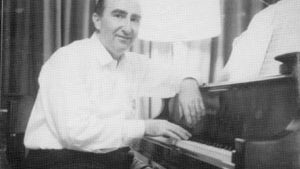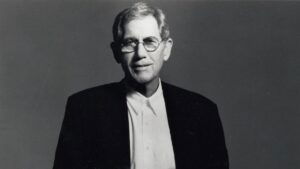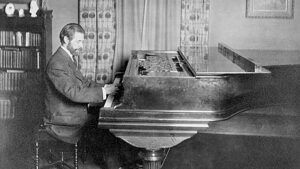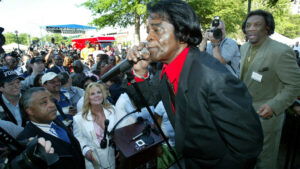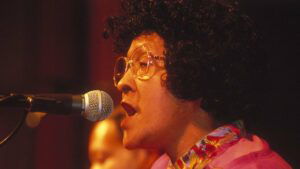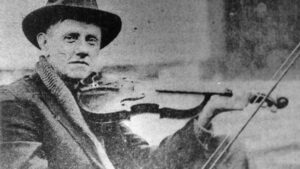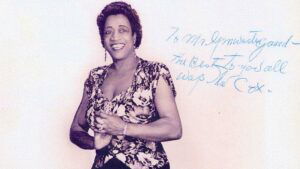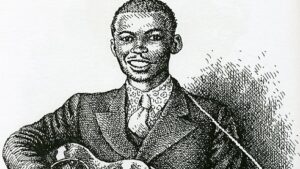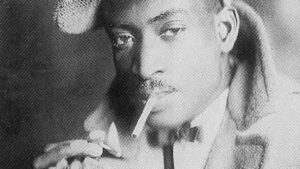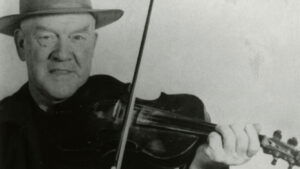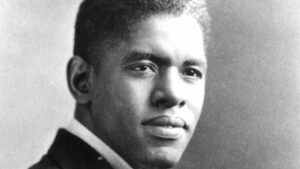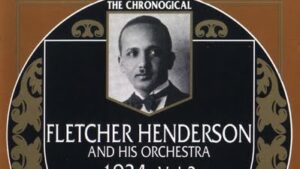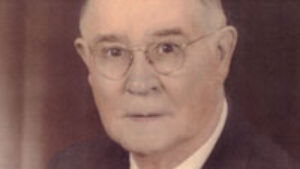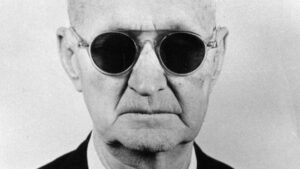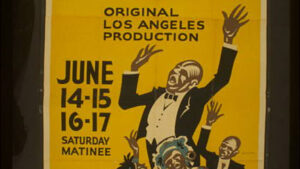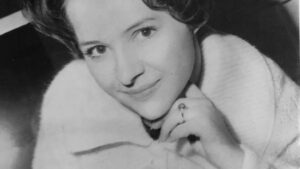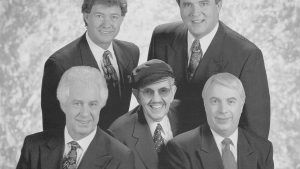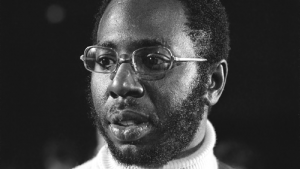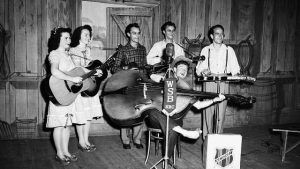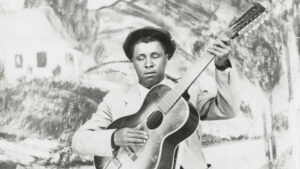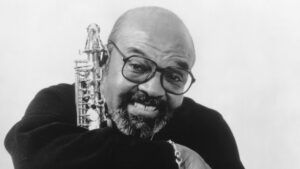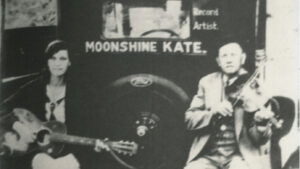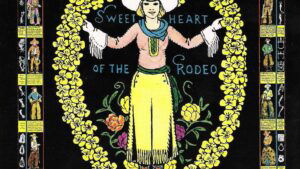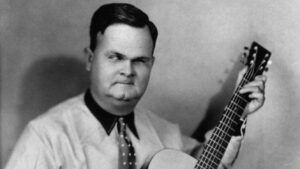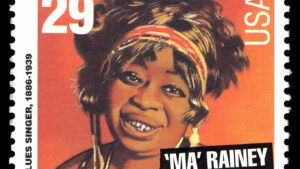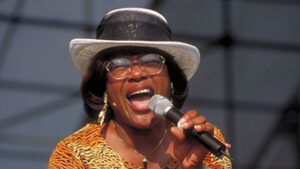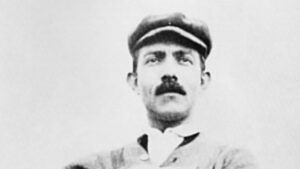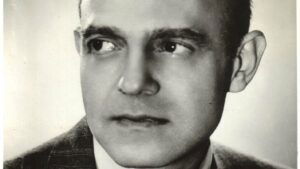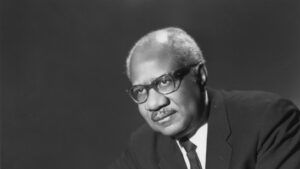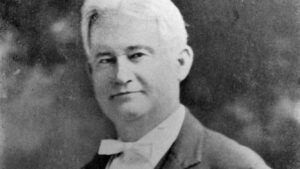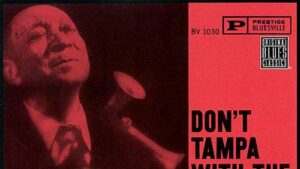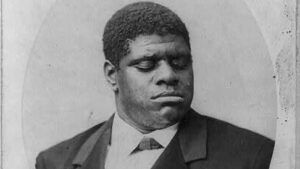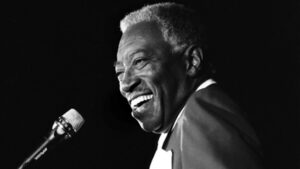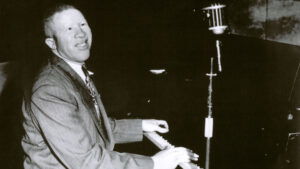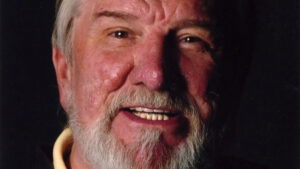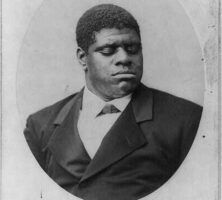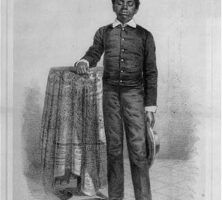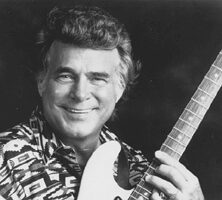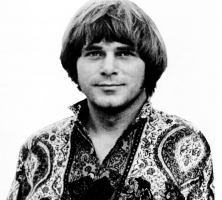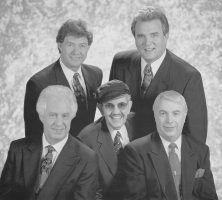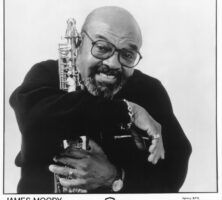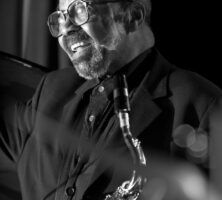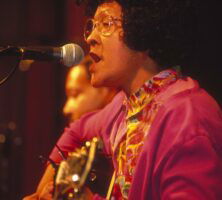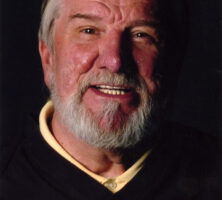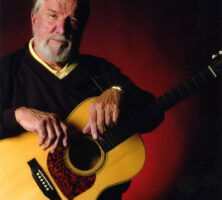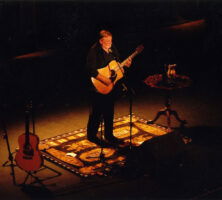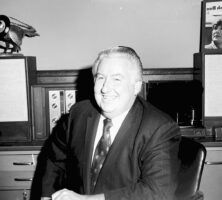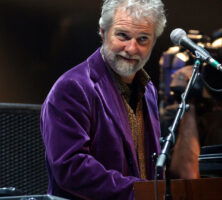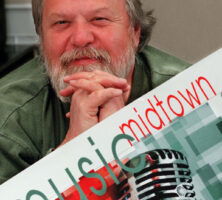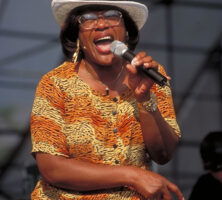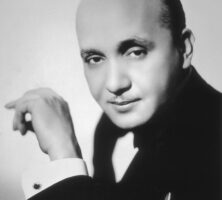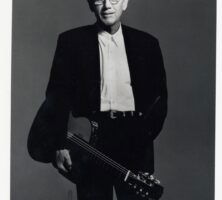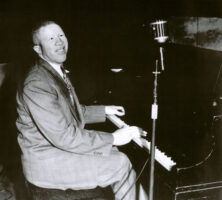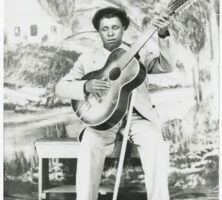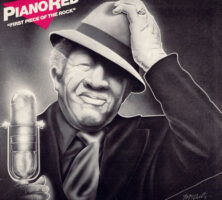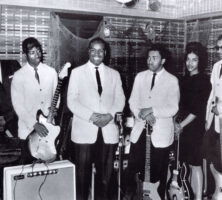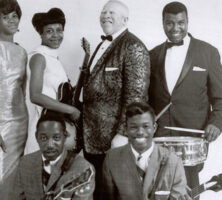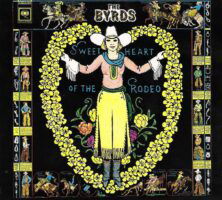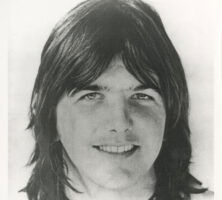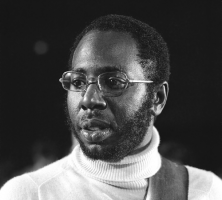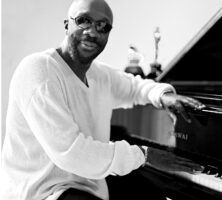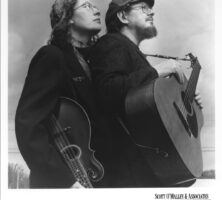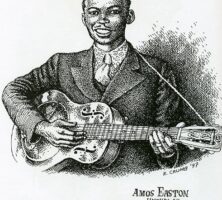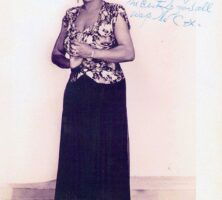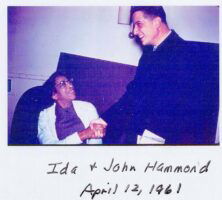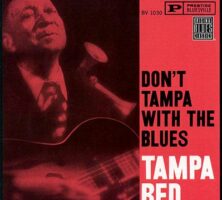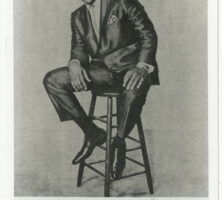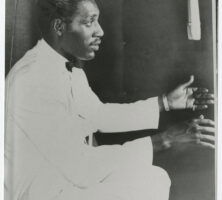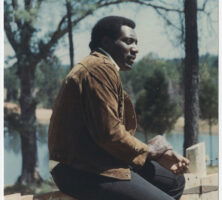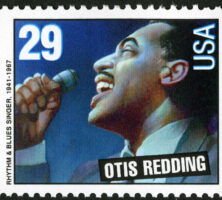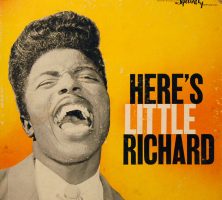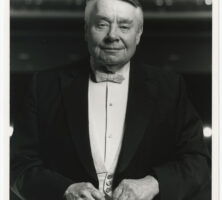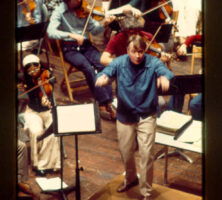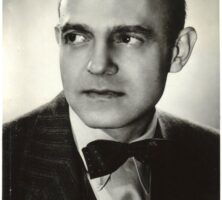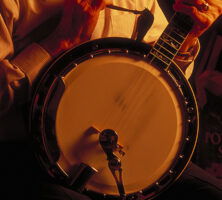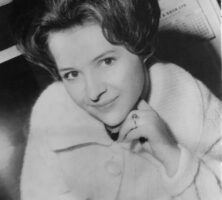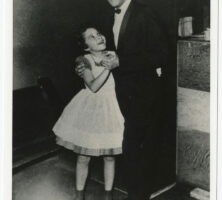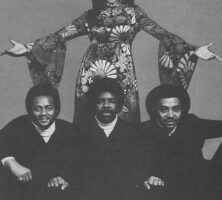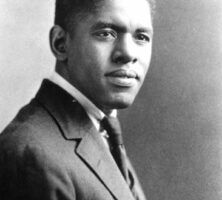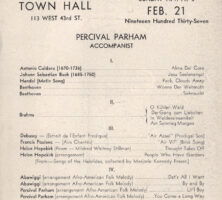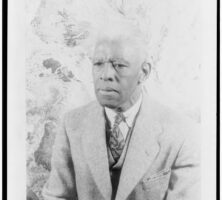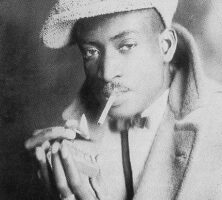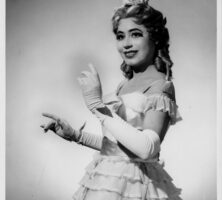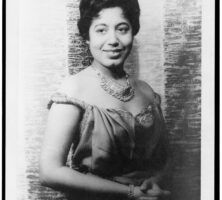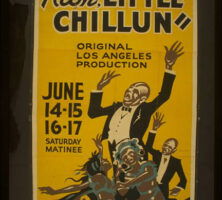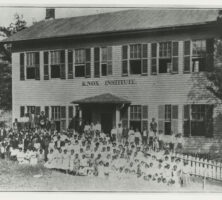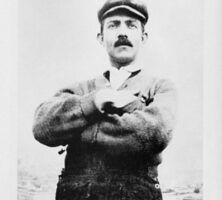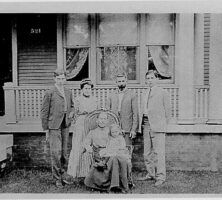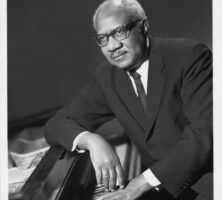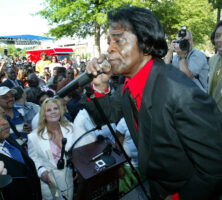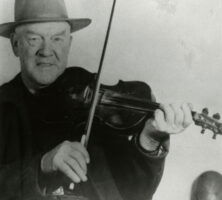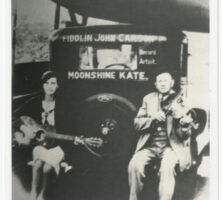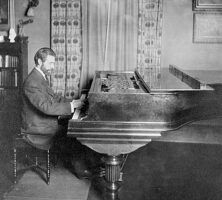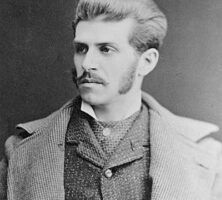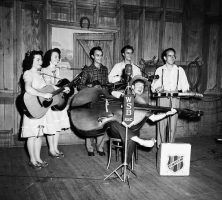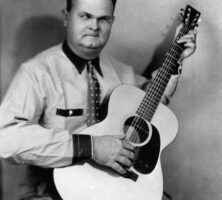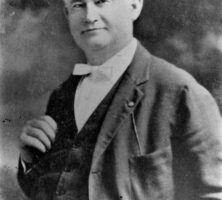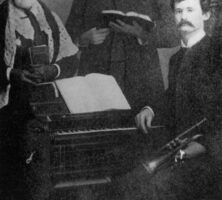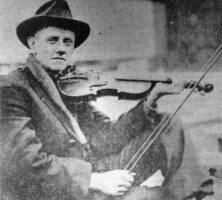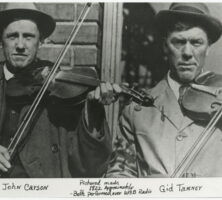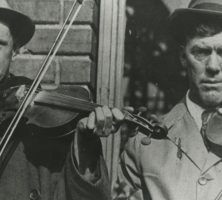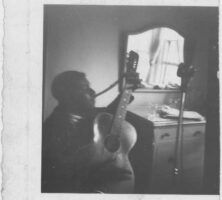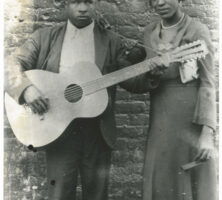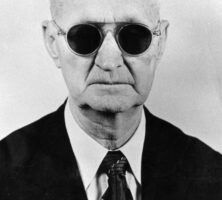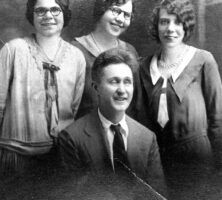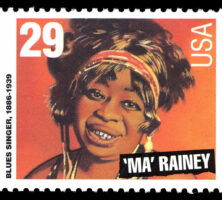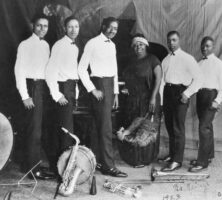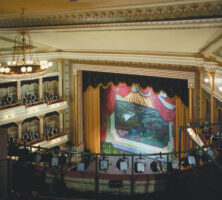The New Georgia Encyclopedia is supported by funding from A More Perfect Union, a special initiative of the National Endowment for the Humanities.
Thomas "Blind Tom" Wiggins, pictured circa 1880, was a musical prodigy. He was born into slave status in Columbus and spent most of his life performing on the piano for audiences around the country. He also wrote original compositions, including the famous "Battle of Manassas."
Courtesy of Library of Congress, Prints and Photographs Division
The New Georgia Encyclopedia does not hold the copyright for this media resource and can neither grant nor deny permission to republish or reproduce the image online or in print. All requests for permission to publish or reproduce the resource must be submitted to the rights holder.
Thomas "Blind Tom" Wiggins, pictured circa 1860 at about the age of ten, was born into slave status in Columbus. He was recognized as a musical prodigy by his owner, James Bethune, and was hired out as a child to traveling showman Perry Oliver. During the presidency of James Buchanan (1857-61), Blind Tom became the first African American musician to perform at the White House.
Courtesy of Library of Congress, Prints and Photographs Division
The New Georgia Encyclopedia does not hold the copyright for this media resource and can neither grant nor deny permission to republish or reproduce the image online or in print. All requests for permission to publish or reproduce the resource must be submitted to the rights holder.
Musician Joe South created the country soul genre in the 1960s. His songs were performed by major country and rock-and-roll singers and groups in the 1960s and 1970s.
Courtesy of Hargrett Rare Book and Manuscript Library, University of Georgia Libraries, Georgia Music Hall of Fame Collection.
The New Georgia Encyclopedia does not hold the copyright for this media resource and can neither grant nor deny permission to republish or reproduce the image online or in print. Requests for permission to publish or reproduce the resource should be submitted to the Hargrett Manuscript and Rare Book Library at the University of Georgia.
Songwriter and musician Joe South won two Grammy Awards for his hit song "Games People Play" in 1969. While working as a studio musician in Muscle Shoals, Alabama, and Nashville, Tennessee, South also played on recordings by such legendary performers as Aretha Franklin, Wilson Pickett, Marty Robbins, and Simon and Garfunkel.
Image from Capitol Records
The New Georgia Encyclopedia does not hold the copyright for this media resource and can neither grant nor deny permission to republish or reproduce the image online or in print. All requests for permission to publish or reproduce the resource must be submitted to the rights holder.
The New Georgia Encyclopedia does not hold the copyright for this media resource and can neither grant nor deny permission to republish or reproduce the image online or in print. All requests for permission to publish or reproduce the resource must be submitted to the rights holder.
The Statesmen were a renowned gospel group formed in 1948 by Hovie Lister. Over the years the lineup of the group changed many times. Pictured is the last configuration of the performers. Seated left to right, Jack Toney (lead), Hovie Lister (pianist), and Wallace Nelms (tenor); standing left to right, Doug Young (bass) and Rick Fair (baritone).
The New Georgia Encyclopedia does not hold the copyright for this media resource and can neither grant nor deny permission to republish or reproduce the image online or in print. All requests for permission to publish or reproduce the resource must be submitted to the rights holder.
Savannah-born James Moody was one of the early innovators of bebop. The jazz saxophonist, composer, and band leader recorded more than fifty albums.
The New Georgia Encyclopedia does not hold the copyright for this media resource and can neither grant nor deny permission to republish or reproduce the image online or in print. All requests for permission to publish or reproduce the resource must be submitted to the rights holder.
The New Georgia Encyclopedia does not hold the copyright for this media resource and can neither grant nor deny permission to republish or reproduce the image online or in print. All requests for permission to publish or reproduce the resource must be submitted to the rights holder.
Jazz musician James Moody, a native of Savannah, performs in 2007 at his eighty-second birthday celebration, held in New York City.
Photograph by Ned Radinsky. Courtesy of rockymountainjazz.com
The New Georgia Encyclopedia does not hold the copyright for this media resource and can neither grant nor deny permission to republish or reproduce the image online or in print. All requests for permission to publish or reproduce the resource must be submitted to the rights holder.
Traditional gospel singer and songwriter Dottie Peoples is also a record producer and the host of the radio show The Dottie Peoples Showcase.
Photograph from Dottie Peoples
The New Georgia Encyclopedia does not hold the copyright for this media resource and can neither grant nor deny permission to republish or reproduce the image online or in print. All requests for permission to publish or reproduce the resource must be submitted to the rights holder.
Babbie Mason is an award-winning contemporary Christian singer and songwriter.
Courtesy of Babbie Mason
The New Georgia Encyclopedia does not hold the copyright for this media resource and can neither grant nor deny permission to republish or reproduce the image online or in print. All requests for permission to publish or reproduce the resource must be submitted to the rights holder.
Blues musician Precious Bryant performs at the Atlanta History Center Blues Festival. Born in Talbot County in 1942, Bryant learned to play guitar as a child and began performing publicly in the 1960s.
Courtesy of Georgia Department of Economic Development.
The New Georgia Encyclopedia does not hold the copyright for this media resource and can neither grant nor deny permission to republish or reproduce the image online or in print. Requests for permission to publish or reproduce the resource may need to be submitted to the Georgia Department of Economic Development.
The New Georgia Encyclopedia does not hold the copyright for this media resource and can neither grant nor deny permission to republish or reproduce the image online or in print. All requests for permission to publish or reproduce the resource must be submitted to the rights holder.
Southern gospel music songwriter and performer Lee Roy Abernathy was an innovator. He invented a music typesetting system, pioneered the use of public address systems in gospel concerts, and wrote the first singing commercials.
Courtesy of Hargrett Rare Book and Manuscript Library, University of Georgia Libraries, Georgia Music Hall of Fame Collection.
The New Georgia Encyclopedia does not hold the copyright for this media resource and can neither grant nor deny permission to republish or reproduce the image online or in print. Requests for permission to publish or reproduce the resource should be submitted to the Hargrett Manuscript and Rare Book Library at the University of Georgia.
Larry Jon Wilson, an Augusta-based singer, songwriter, and composer, began his musical career in 1975 with the release of his first album, New Beginnings. His work is described by critics as a blend of country, soul, and folk.
Courtesy of Larry Jon Wilson
The New Georgia Encyclopedia does not hold the copyright for this media resource and can neither grant nor deny permission to republish or reproduce the image online or in print. All requests for permission to publish or reproduce the resource must be submitted to the rights holder.
Georgia singer, songwriter Larry Jon Wilson with his guitar. WIlson's released his first album in 1975 and released six more before his death in 2010.
Courtesy of Larry Jon Wilson
The New Georgia Encyclopedia does not hold the copyright for this media resource and can neither grant nor deny permission to republish or reproduce the image online or in print. All requests for permission to publish or reproduce the resource must be submitted to the rights holder.
Singer, Songwriter Larry Jon Wilson performing on stage. Wilson taught himself to play the guitar at age thirty and soon transferred from a career in chemistry to one in music.
Courtesy of Larry Jon Wilson
The New Georgia Encyclopedia does not hold the copyright for this media resource and can neither grant nor deny permission to republish or reproduce the image online or in print. All requests for permission to publish or reproduce the resource must be submitted to the rights holder.
Bill Lowery began his career in Atlanta as a disc jockey and broadcaster for Georgia Tech football games at radio station WGST in 1948. His weekly programs at the station included Musical Tune and Uncle Ebenezer Brown.
The New Georgia Encyclopedia does not hold the copyright for this media resource and can neither grant nor deny permission to republish or reproduce the image online or in print. Requests for permission to publish or reproduce the resource should be submitted to Special Collections and Archives at Georgia State University.
Bill Lowery, pictured in 1969, poses at Bill Lowery Enterprises, which included the Lowery Music Company and the National Recording Corporation. Lowery, known as "Mr. Atlanta Music," was a prominent disc jockey, producer, manager, and music publisher in the city from 1948 until his death in 2004. He was one of the first two inductees into the Georgia Music Hall of Fame, which he also helped to establish.
The New Georgia Encyclopedia does not hold the copyright for this media resource and can neither grant nor deny permission to republish or reproduce the image online or in print. Requests for permission to publish or reproduce the resource should be submitted to Special Collections and Archives at Georgia State University.
The rap musician Ludacris poses in 2003 outside the Def Jam South offices in Midtown Atlanta. Ludacris signed with Def Jam in 2000 and later that year released the album Back for the First Time, which contained his first national hit, "What's Your Fantasy?"
Courtesy of Atlanta Journal-Constitution.
The New Georgia Encyclopedia does not hold the copyright for this media resource and can neither grant nor deny permission to republish or reproduce the image online or in print. All requests for permission to publish or reproduce the resource must be submitted to the Atlanta Journal-Constitution.
Ludacris, a rapper in the "Dirty South" style, performs during the 2005 Vibe Music Festival at the Georgia Dome in Atlanta. Ludacris began his career as a disc jockey in Atlanta and relased his first album, Incognegro, in 2000. The following year he established the Ludacris Foundation for underprivileged children in Atlanta.
Courtesy of Atlanta Journal-Constitution.
The New Georgia Encyclopedia does not hold the copyright for this media resource and can neither grant nor deny permission to republish or reproduce the image online or in print. All requests for permission to publish or reproduce the resource must be submitted to the Atlanta Journal-Constitution.
Usher, a native of Chattanooga, Tennessee, began his recording career in 1994 with Atlanta-based LaFace Records. In 2001 the artist received two Grammy awards. Usher has also starred in several feature films.
Courtesy of Atlanta Journal-Constitution.
The New Georgia Encyclopedia does not hold the copyright for this media resource and can neither grant nor deny permission to republish or reproduce the image online or in print. All requests for permission to publish or reproduce the resource must be submitted to the Atlanta Journal-Constitution.
Country musician Travis Tritt performs at the Country Fair 2000 in his hometown of Marietta. That year, Tritt released Down the Road I Go, his eighth new album and the first with Columbia Records.
Courtesy of Atlanta Journal-Constitution.
The New Georgia Encyclopedia does not hold the copyright for this media resource and can neither grant nor deny permission to republish or reproduce the image online or in print. All requests for permission to publish or reproduce the resource must be submitted to the Atlanta Journal-Constitution.
Travis Tritt, a native of Marietta, is a Grammy Award-winning country musician and member of the Grand Ole Opry. In 1999 he was inducted into the Georgia Music Hall of Fame. Tritt's platinum-selling albums include Country Club (1990), It's All about to Change (1991), and T-R-O-U-B-L-E (1994).
Courtesy of Atlanta Journal-Constitution.
The New Georgia Encyclopedia does not hold the copyright for this media resource and can neither grant nor deny permission to republish or reproduce the image online or in print. All requests for permission to publish or reproduce the resource must be submitted to the Atlanta Journal-Constitution.
The New Georgia Encyclopedia does not hold the copyright for this media resource and can neither grant nor deny permission to republish or reproduce the image online or in print. All requests for permission to publish or reproduce the resource must be submitted to the rights holder.
Chuck Leavell stands among the longleaf pines on Charlane Plantation, his timber farm and hunting preserve in Twiggs County. Leavell and his wife, Rose, have received state and national awards recognizing their efforts in conservation.
Courtesy of Atlanta Journal-Constitution.
The New Georgia Encyclopedia does not hold the copyright for this media resource and can neither grant nor deny permission to republish or reproduce the image online or in print. All requests for permission to publish or reproduce the resource must be submitted to the Atlanta Journal-Constitution.
Pianist Chuck Leavell, a resident of Twiggs County since the early 1980s, has played with such notable acts as the Allman Brothers Band and the Rolling Stones. Inducted into the Georgia Music Hall of Fame in 2004, Leavell has also released several solo albums.
Courtesy of Atlanta Journal-Constitution.
The New Georgia Encyclopedia does not hold the copyright for this media resource and can neither grant nor deny permission to republish or reproduce the image online or in print. All requests for permission to publish or reproduce the resource must be submitted to the Atlanta Journal-Constitution.
Alex Cooley, pictured in 1978, owned and operated a number of the best-known rock venues in Atlanta, including Alex Cooley's Electric Ballroom and the Tabernacle. In 1987 Cooley was inducted as a nonperformer into the Georgia Music Hall of Fame.
Courtesy of Atlanta Journal-Constitution.
The New Georgia Encyclopedia does not hold the copyright for this media resource and can neither grant nor deny permission to republish or reproduce the image online or in print. All requests for permission to publish or reproduce the resource must be submitted to the Atlanta Journal-Constitution.
Alex Cooley gives an interview to the Atlanta Journal-Constitution in 1998. Cooley became a concert promoter during the late 1960s and founded the city's Midtown Music Festival in 1994.
Courtesy of Atlanta Journal-Constitution.
The New Georgia Encyclopedia does not hold the copyright for this media resource and can neither grant nor deny permission to republish or reproduce the image online or in print. All requests for permission to publish or reproduce the resource must be submitted to the Atlanta Journal-Constitution.
Francine Reed performs at Music Midtown, an annual festival in Atlanta begun in 1990s. A native of Illinois, Reed became known as Atlanta's "queen of the blues" following her move to Georgia in the early 1990s.
Courtesy of Georgia Department of Economic Development.
The New Georgia Encyclopedia does not hold the copyright for this media resource and can neither grant nor deny permission to republish or reproduce the image online or in print. Requests for permission to publish or reproduce the resource may need to be submitted to the Georgia Department of Economic Development.
Fletcher Henderson, a native of Randolph County, formed the first big band orchestra around 1920 in New York City. In 1921 Fletcher's orchestra began making records, and the group played at the Roseland Ballroom in New York for the rest of the decade.
The New Georgia Encyclopedia does not hold the copyright for this media resource and can neither grant nor deny permission to republish or reproduce the image online or in print. All requests for permission to publish or reproduce the resource must be submitted to the rights holder.
Fletcher Henderson, an accomplished pianist and native of Cuthbert, is credited with forming the first big band orchestra in New York City during the 1920s. His musical contributions laid the foundation for swing music.
Image from Wikimedia
The New Georgia Encyclopedia does not hold the copyright for this media resource and can neither grant nor deny permission to republish or reproduce the image online or in print. All requests for permission to publish or reproduce the resource must be submitted to the rights holder.
The New Georgia Encyclopedia does not hold the copyright for this media resource and can neither grant nor deny permission to republish or reproduce the image online or in print. All requests for permission to publish or reproduce the resource must be submitted to the rights holder.
A publicity photo of Chet Atkins, a famed country music star credited with increasing country music's mainstream popularity. He won more than a dozen Grammy awards over his lifetime, and was inducted into the Georgia Music Hall of Fame in 1995.
Copyright 1997 SonyMusic Entertainment Inc.
The New Georgia Encyclopedia does not hold the copyright for this media resource and can neither grant nor deny permission to republish or reproduce the image online or in print. All requests for permission to publish or reproduce the resource must be submitted to the rights holder.
Willie Lee, or "Piano Red," Perryman was a blues pianist who played in the barrelhouse style. His professional music career began in the early 1930s and continued until the late 1960s.
Photograph from booklet "Piano Red, Dr. Feelgood," by Norbert Hess
The New Georgia Encyclopedia does not hold the copyright for this media resource and can neither grant nor deny permission to republish or reproduce the image online or in print. All requests for permission to publish or reproduce the resource must be submitted to the rights holder.
Blind Willie McTell, a native of Thomson, was a great blues musician of the 1920s and 1930s. Based in Atlanta, he displayed an extraordinary range on the twelve-string guitar.
The New Georgia Encyclopedia does not hold the copyright for this media resource and can neither grant nor deny permission to republish or reproduce the image online or in print. Requests for permission to publish or reproduce the resource should be submitted to the Hargrett Manuscript and Rare Book Library at the University of Georgia.
First Piece of the Rock was released in 1983 as a tribute to Willie Lee Perryman, a blues musician known as "Piano Red" for much of his career. Two of Perryman's songs, "Rockin' with Red" and "Red's Boogie," were recorded in Atlanta in 1950 and made the national charts.
Print by Mike McCarty. Courtesy of Lowery Group
The New Georgia Encyclopedia does not hold the copyright for this media resource and can neither grant nor deny permission to republish or reproduce the image online or in print. All requests for permission to publish or reproduce the resource must be submitted to the rights holder.
Willie Lee Perryman, a blues pianist, created the Dr. Feelgood persona for his WAOK radio show, and he performed under the name with his band, the Interns. From left, Perryman, Curtis Smith, Bobby Lee Tuggle, Roy Lee Johnson, Beverly Watkins, and Howard Hobbs.
Photograph from booklet "Piano Red, Dr. Feelgood," by Norbert Hess
The New Georgia Encyclopedia does not hold the copyright for this media resource and can neither grant nor deny permission to republish or reproduce the image online or in print. All requests for permission to publish or reproduce the resource must be submitted to the rights holder.
Willie Lee Perryman, also known as "Dr. Feelgood," poses in the early 1960s with his band, the Interns.
Photograph from booklet "Piano Red, Dr. Feelgood," by Norbert Hess
The New Georgia Encyclopedia does not hold the copyright for this media resource and can neither grant nor deny permission to republish or reproduce the image online or in print. All requests for permission to publish or reproduce the resource must be submitted to the rights holder.
Duane Allman was the guitarist for the Allman Brothers Band, which he formed with his younger brother, Gregg, in 1969. The band released its first album on Capricorn Records, a label based in Macon. Allman died in 1971 after being injured in a motorcycle accident.
The New Georgia Encyclopedia does not hold the copyright for this media resource and can neither grant nor deny permission to republish or reproduce the image online or in print. All requests for permission to publish or reproduce the resource must be submitted to the rights holder.
The New Georgia Encyclopedia does not hold the copyright for this media resource and can neither grant nor deny permission to republish or reproduce the image online or in print. All requests for permission to publish or reproduce the resource must be submitted to the rights holder.
Lena Horne, an acclaimed entertainer and civil rights activist, is pictured in a 1946 publicity still for Till the Clouds Roll By. Born in Brooklyn, New York, Horne spent part of her childhood in both Fort Valley and Atlanta before beginning her career in New York at the age of sixteen. In 1984 she received the Kennedy Center Honor for lifetime achievement in the performing arts.
Image from Wikimedia
The New Georgia Encyclopedia does not hold the copyright for this media resource and can neither grant nor deny permission to republish or reproduce the image online or in print. All requests for permission to publish or reproduce the resource must be submitted to the rights holder.
Harry James, a renowned swing trumpet player during the 1930s and 1940s, rehearses for the Coca-Cola radio show in New York City around 1946. James was born in Albany to traveling circus performers and began playing the trumpet as a child.
Courtesy of Library of Congress, Music Division, William P. Gottlieb/Ira and Leonore S. Gershwin Fund Collection.
The New Georgia Encyclopedia does not hold the copyright for this media resource and can neither grant nor deny permission to republish or reproduce the image online or in print. All requests for permission to publish or reproduce the resource must be submitted to the rights holder.
The New Georgia Encyclopedia does not hold the copyright for this media resource and can neither grant nor deny permission to republish or reproduce the image online or in print. All requests for permission to publish or reproduce the resource must be submitted to the rights holder.
Pictured in New York circa 1947, Harry James was a renowned trumpet player and band leader. The Albany native played with some of the most prominent performers of the swing era, including Benny Goodman and Connie Haines.
Courtesy of Library of Congress, Music Division, William P. Gottlieb/Ira and Leonore S. Gershwin Fund Collection.
The New Georgia Encyclopedia does not hold the copyright for this media resource and can neither grant nor deny permission to republish or reproduce the image online or in print. All requests for permission to publish or reproduce the resource must be submitted to the rights holder.
Gram Parsons's work on the album Sweetheart of the Rodeo (1968) earned critical success and increased popularity for the Byrds, but it turned out to be the only album Parsons would record with the band.
The New Georgia Encyclopedia does not hold the copyright for this media resource and can neither grant nor deny permission to republish or reproduce the image online or in print. All requests for permission to publish or reproduce the resource must be submitted to the rights holder.
Gram Parsons's influence on other musicians stems from his innovative fusion of the country and rock genres. Though he died young in the early 1970s, Parsons left behind a body of work that continues to earn the admiration of contemporary musicians.
Courtesy of Hargrett Rare Book and Manuscript Library, University of Georgia Libraries, Georgia Music Hall of Fame Collection.
The New Georgia Encyclopedia does not hold the copyright for this media resource and can neither grant nor deny permission to republish or reproduce the image online or in print. Requests for permission to publish or reproduce the resource should be submitted to the Hargrett Manuscript and Rare Book Library at the University of Georgia.
Vocalist Emmylou Harris recorded two albums with Gram Parsons: GP (1973) and Grievous Angel (1974). Between the releases of these two records, Harris toured with Parsons's Fallen Angels band.
Photograph copyright Geoff Gibbs
The New Georgia Encyclopedia does not hold the copyright for this media resource and can neither grant nor deny permission to republish or reproduce the image online or in print. All requests for permission to publish or reproduce the resource must be submitted to the rights holder.
Curtis Mayfield began his career as a professional musician at age sixteen. His longtime affiliation with a vocal group called the Impressions was followed by a series of successful and influential solo projects. Today Mayfield is revered by many for his pioneering work in the soul and funk genres.
Image from Wikimedia
The New Georgia Encyclopedia does not hold the copyright for this media resource and can neither grant nor deny permission to republish or reproduce the image online or in print. All requests for permission to publish or reproduce the resource must be submitted to the rights holder.
Propelled by two chart-climbing singles, Toni Braxton achieved stardom before the release of her first full-length record. When the rhythm-and-blues singer's debut album, Toni Braxton, finally came out in 1993, it sold more than 9 million copies.
Courtesy of Hargrett Rare Book and Manuscript Library, University of Georgia Libraries, Georgia Music Hall of Fame Collection.
The New Georgia Encyclopedia does not hold the copyright for this media resource and can neither grant nor deny permission to republish or reproduce the image online or in print. Requests for permission to publish or reproduce the resource should be submitted to the Hargrett Manuscript and Rare Book Library at the University of Georgia.
In his unique career, Jermaine Dupri has been a breakdancer, songwriter, music producer, entrepreneur, rapper, and athletics manager. He has held high-level positions at major record companies, in addition to owning Atlanta-based So So Def Records, and he has produced several music acts that have gone on to sell millions of albums each.
Image from Timothy M. Moore
The New Georgia Encyclopedia does not hold the copyright for this media resource and can neither grant nor deny permission to republish or reproduce the image online or in print. All requests for permission to publish or reproduce the resource must be submitted to the rights holder.
Isaac Hayes, credited with developing the "Memphis soul" sound in the 1960s and 1970s, was inducted into the Georgia Music Hall of Fame in 1994. A Tennessee native, Hayes lived in Atlanta from the mid-1970s until 1992.
Courtesy of www.isaachayes.com
The New Georgia Encyclopedia does not hold the copyright for this media resource and can neither grant nor deny permission to republish or reproduce the image online or in print. All requests for permission to publish or reproduce the resource must be submitted to the rights holder.
Isaac Hayes, an innovative soul musician, greets onlookers along the red carpet at the 2004 Turner Broadcasting System's Trumpet Awards, held at the Omni Hotel in Atlanta. Hayes began as a rhythm-and-blues musician in Memphis, Tennessee, before establishing himself as a soul musician with the 1969 album Hot Buttered Soul.
Courtesy of Atlanta Journal-Constitution.
The New Georgia Encyclopedia does not hold the copyright for this media resource and can neither grant nor deny permission to republish or reproduce the image online or in print. All requests for permission to publish or reproduce the resource must be submitted to the Atlanta Journal-Constitution.
The New Georgia Encyclopedia does not hold the copyright for this media resource and can neither grant nor deny permission to republish or reproduce the image online or in print. All requests for permission to publish or reproduce the resource must be submitted to the rights holder.
Soul musician Isaac Hayes performs in 2003 at Philips Arena (later State Farm Arena) in Atlanta during an NBA All-Star event.
Courtesy of Atlanta Journal-Constitution.
The New Georgia Encyclopedia does not hold the copyright for this media resource and can neither grant nor deny permission to republish or reproduce the image online or in print. All requests for permission to publish or reproduce the resource must be submitted to the Atlanta Journal-Constitution.
Norman Blake, a highly regarded perfomer of traditional southern music, married musician Nancy Blake in 1972. Since that time, the two have often performed and recorded together.
Courtesy of Hargrett Rare Book and Manuscript Library, University of Georgia Libraries, Georgia Music Hall of Fame Collection.
The New Georgia Encyclopedia does not hold the copyright for this media resource and can neither grant nor deny permission to republish or reproduce the image online or in print. Requests for permission to publish or reproduce the resource should be submitted to the Hargrett Manuscript and Rare Book Library at the University of Georgia.
Bumble Bee Slim Easton, a native of Brunswick, became a prominent blues musician in Chicago, Illinois, where he recorded more than 150 songs during the 1930s.
Courtesy of Hargrett Rare Book and Manuscript Library, University of Georgia Libraries, Georgia Music Hall of Fame Collection.
The New Georgia Encyclopedia does not hold the copyright for this media resource and can neither grant nor deny permission to republish or reproduce the image online or in print. Requests for permission to publish or reproduce the resource should be submitted to the Hargrett Manuscript and Rare Book Library at the University of Georgia.
Ida Cox, a Georgia native, began her career as a vaudeville performer. She recorded her first blues songs in 1923 for the Paramount label, which dubbed her the "Uncrowned Queen of the Blues." By 1929, Cox had recorded seventy-eight songs, most of which she had written herself.
The New Georgia Encyclopedia does not hold the copyright for this media resource and can neither grant nor deny permission to republish or reproduce the image online or in print. All requests for permission to publish or reproduce the resource must be submitted to the rights holder.
Ida Cox, a successful blues singer of the 1920s, meets with John Hammond some years after her 1939 performance in his From Spirituals to Swing concert for an integrated audience at Carnegie Hall in New York City. Hammond, a prominent musician and producer, worked throughout the 1930s to integrate the music business.
The New Georgia Encyclopedia does not hold the copyright for this media resource and can neither grant nor deny permission to republish or reproduce the image online or in print. All requests for permission to publish or reproduce the resource must be submitted to the rights holder.
The New Georgia Encyclopedia does not hold the copyright for this media resource and can neither grant nor deny permission to republish or reproduce the image online or in print. All requests for permission to publish or reproduce the resource must be submitted to the rights holder.
Tampa Red Whittaker, a native of Smithville, was a prominent Chicago blues musician during the 1930s and 1940s.
The New Georgia Encyclopedia does not hold the copyright for this media resource and can neither grant nor deny permission to republish or reproduce the image online or in print. All requests for permission to publish or reproduce the resource must be submitted to the rights holder.
The New Georgia Encyclopedia does not hold the copyright for this media resource and can neither grant nor deny permission to republish or reproduce the image online or in print. All requests for permission to publish or reproduce the resource must be submitted to the rights holder.
Otis Redding, a Georgia native, was an influentual rhythm-and-blues and soul musician during the 1960s. Killed in an airplane crash in 1967, Redding was posthumously honored by a statue in Macon, his hometown, and induction into both the Georgia Music Hall of Fame and the Rock and Roll Hall of Fame.
The New Georgia Encyclopedia does not hold the copyright for this media resource and can neither grant nor deny permission to republish or reproduce the image online or in print. Requests for permission to publish or reproduce the resource should be submitted to the Hargrett Manuscript and Rare Book Library at the University of Georgia.
Otis Redding, an influential soul musician, began his musical career with "Little Richard" Penniman after dropping out of high school. In 1960 he joined Johnny Jenkins and the Pinetoppers as a vocalist and recorded his first hit song, "These Arms of Mine," for Stax Records in 1962.
The New Georgia Encyclopedia does not hold the copyright for this media resource and can neither grant nor deny permission to republish or reproduce the image online or in print. Requests for permission to publish or reproduce the resource should be submitted to the Hargrett Manuscript and Rare Book Library at the University of Georgia.
Although Otis Redding achieved success as a rhythm-and-blues and soul musician during the early 1960s, he did not receive much mainstream attention until the release of his song "I've Been Loving You Too Long (To Stop Now)" in 1965. In 1967 Redding released the crossover hit "Try a Little Tenderness" and was the only soul act to appear at the Monterey Pop Festival in California.
The New Georgia Encyclopedia does not hold the copyright for this media resource and can neither grant nor deny permission to republish or reproduce the image online or in print. Requests for permission to publish or reproduce the resource should be submitted to the Hargrett Manuscript and Rare Book Library at the University of Georgia.
Otis Redding, a soul musician whose work influenced such rock acts as the Rolling Stones, achieved his single number-one recording with the release of "(Sittin' on) The Dock of the Bay." The song was released three months after Redding's death in an airplane crash on December 10, 1967.
The New Georgia Encyclopedia does not hold the copyright for this media resource and can neither grant nor deny permission to republish or reproduce the image online or in print. Requests for permission to publish or reproduce the resource should be submitted to the Hargrett Manuscript and Rare Book Library at the University of Georgia.
The U.S. Postal Service's American Music Series commemorated the life of Georgia soul musician Otis Redding in 1992.
Courtesy of Smithsonian National Postal Museum
The New Georgia Encyclopedia does not hold the copyright for this media resource and can neither grant nor deny permission to republish or reproduce the image online or in print. All requests for permission to publish or reproduce the resource must be submitted to the rights holder.
Little Richard's debut album, Here's Little Richard, was released in 1957 by Specialty Records.
Photography by Jay Miller
The New Georgia Encyclopedia does not hold the copyright for this media resource and can neither grant nor deny permission to republish or reproduce the image online or in print. All requests for permission to publish or reproduce the resource must be submitted to the rights holder.
Little Richard Penniman, known as "the Georgia Peach," claimed to be "the innovator and the architect of rock and roll." From 1956 to 1957 he recorded a string of hits before renouncing show business to enter the seminary. He returned to the stage in 1962 and continued to perform into his seventies. In 1986 Little Richard was one of the first inductees into the Rock and Roll Hall of Fame.
Image from Wikimedia
The New Georgia Encyclopedia does not hold the copyright for this media resource and can neither grant nor deny permission to republish or reproduce the image online or in print. All requests for permission to publish or reproduce the resource must be submitted to the rights holder.
Robert Shaw conducted the Atlanta Symphony Orchestra from 1967 to 1988. Credited with building the symphony into a major American orchestra, Shaw received many national and international honors throughout his long career.
The New Georgia Encyclopedia does not hold the copyright for this media resource and can neither grant nor deny permission to republish or reproduce the image online or in print. Requests for permission to publish or reproduce the resource should be submitted to the Hargrett Manuscript and Rare Book Library at the University of Georgia.
Robert Shaw leads a rehearsal of the Atlanta Symphony Orchestra, circa 1970.
Courtesy of Atlanta Symphony Orchestra Archive
The New Georgia Encyclopedia does not hold the copyright for this media resource and can neither grant nor deny permission to republish or reproduce the image online or in print. All requests for permission to publish or reproduce the resource must be submitted to the rights holder.
The New Georgia Encyclopedia does not hold the copyright for this media resource and can neither grant nor deny permission to republish or reproduce the image online or in print. All requests for permission to publish or reproduce the resource must be submitted to the rights holder.
The Atlanta Symphony Orchestra and Chorus, led by conductor Robert Shaw, is pictured during a performance in 1973. .
Courtesy of Special Collections & Archives, Georgia State University Library, Atlanta Journal-Constitution Photographic Archive.
The New Georgia Encyclopedia does not hold the copyright for this media resource and can neither grant nor deny permission to republish or reproduce the image online or in print. Requests for permission to publish or reproduce the resource should be submitted to Special Collections and Archives at Georgia State University.
Classical pianist and composer Beryl Rubinstein spent much of his career at the Cleveland Institute of Music, where he served in a number of capacities, including head of the piano department, dean of faculty, and director of the school. Rubinstein, born in Athens in 1898, returned to Georgia in May 1952 to perform concerts in Athens and Atlanta.
Courtesy of Cleveland Institute of Music
The New Georgia Encyclopedia does not hold the copyright for this media resource and can neither grant nor deny permission to republish or reproduce the image online or in print. All requests for permission to publish or reproduce the resource must be submitted to the rights holder.
Jessye Norman, a native of Augusta, was a world-renowned and highly-decorated operatic soprano. In her lifetime, she received more than thirty honorary degrees, won five Grammys, was awarded the French Legion of Honor, and became the youngest recipient of the Kennedy Center Honor at the age of just fifty-one.
Photograph by John Mathew Smith
The New Georgia Encyclopedia does not hold the copyright for this media resource and can neither grant nor deny permission to republish or reproduce the image online or in print. All requests for permission to publish or reproduce the resource must be submitted to the rights holder.
Jessye Norman, an Augusta native, began her career as an opera singer in 1969 with the Deutsche Oper Berlin in Germany. She subsequently performed in Milan, Italy, and London, England, before making her debut at the New York Metropolitan Opera in 1983.
Image from the Walters Art Museum in Baltimore
The New Georgia Encyclopedia does not hold the copyright for this media resource and can neither grant nor deny permission to republish or reproduce the image online or in print. All requests for permission to publish or reproduce the resource must be submitted to the rights holder.
The New Georgia Encyclopedia does not hold the copyright for this media resource and can neither grant nor deny permission to republish or reproduce the image online or in print. All requests for permission to publish or reproduce the resource must be submitted to the rights holder.
The New Georgia Encyclopedia does not hold the copyright for this media resource and can neither grant nor deny permission to republish or reproduce the image online or in print. All requests for permission to publish or reproduce the resource must be submitted to the rights holder.
Brenda Lee began her career as a singer at the age of five and continues to perform into the twenty-first century. A rockabilly performer in her early days, Lee later adopted adult contemporary and country styles. She is the only woman to be inducted into both the Country Music Hall of Fame and the Rock and Roll Hall of Fame.
Image from Bradford Timeline
The New Georgia Encyclopedia does not hold the copyright for this media resource and can neither grant nor deny permission to republish or reproduce the image online or in print. All requests for permission to publish or reproduce the resource must be submitted to the rights holder.
Rockabilly singer Brenda Lee began performing in the Atlanta area at the age of five. In 1957 she met Elvis Presley for the first time and performed with him in a Grand Ole Opry performance at the Ryman Auditorium in Nashville, Tennessee.
The New Georgia Encyclopedia does not hold the copyright for this media resource and can neither grant nor deny permission to republish or reproduce the image online or in print. Requests for permission to publish or reproduce the resource should be submitted to the Hargrett Manuscript and Rare Book Library at the University of Georgia.
As a young man, the rockabilly singer Jerry Reed moved from Atlanta to Nashville, Tennessee, to record with Capitol Records from 1955 to 1958. In 1958 he returned to Atlanta and recorded with the National Recording Corporation before joining the army.
Courtesy of Hargrett Rare Book and Manuscript Library, University of Georgia Libraries, Georgia Music Hall of Fame Collection.
The New Georgia Encyclopedia does not hold the copyright for this media resource and can neither grant nor deny permission to republish or reproduce the image online or in print. Requests for permission to publish or reproduce the resource should be submitted to the Hargrett Manuscript and Rare Book Library at the University of Georgia.
Jerry Reed's long career in the country and pop music industry began in 1955, when he was eighteen years old, and continued into the twenty-first century. In addition to writing and recording his own songs, Reed has worked as a session musician for such artists as Willie Nelson and Elvis Presley and as a producer on his own record label.
Image from SSGT Lee Schading
The New Georgia Encyclopedia does not hold the copyright for this media resource and can neither grant nor deny permission to republish or reproduce the image online or in print. All requests for permission to publish or reproduce the resource must be submitted to the rights holder.
The New Georgia Encyclopedia does not hold the copyright for this media resource and can neither grant nor deny permission to republish or reproduce the image online or in print. All requests for permission to publish or reproduce the resource must be submitted to the rights holder.
Gladys Knight and the Pips formed in 1952 and toured the "Chitlin' Circuit" throughout the 1950s. In the late 1960s and early 1970s the group recorded its biggest hits, including "I Heard It through the Grapevine" (1967) and "Midnight Train to Georgia" (1973).
The New Georgia Encyclopedia does not hold the copyright for this media resource and can neither grant nor deny permission to republish or reproduce the image online or in print. All requests for permission to publish or reproduce the resource must be submitted to the rights holder.
Gladys Knight began her solo career in the late 1980s after reuniting briefly with her family band, the Pips, earlier in the decade.
Image from John Mathew Smith
The New Georgia Encyclopedia does not hold the copyright for this media resource and can neither grant nor deny permission to republish or reproduce the image online or in print. All requests for permission to publish or reproduce the resource must be submitted to the rights holder.
Roland Hayes, the renowned African American tenor, earned international acclaim by singing classical and operatic music on the concert stage. Initially compelled to arrange and promote his own concerts, Hayes eventually became the highest-paid tenor in the world, despite the racial barriers that often excluded African Americans from careers in classical music.
Courtesy of Gordon County Chamber of Commerce
The New Georgia Encyclopedia does not hold the copyright for this media resource and can neither grant nor deny permission to republish or reproduce the image online or in print. All requests for permission to publish or reproduce the resource must be submitted to the rights holder.
This image of Roland Hayes, the internationally known African American tenor, appeared on a program for a 1937 concert he gave in New York City. Hayes began his career with the renowned Jubilee Singers at Fisk University in Nashville, Tennessee, and performed his final concert over fifty years later at Carnegie Hall in New York.
Courtesy of University of Iowa Libraries, Redpath Chautauqua Collection.
The New Georgia Encyclopedia does not hold the copyright for this media resource and can neither grant nor deny permission to republish or reproduce the image online or in print. All requests for permission to publish or reproduce the resource must be submitted to the rights holder.
Roland Hayes, the famous Black tenor, often incorporated "Aframerican religious folk music," or spirituals, into his classical repertoire, as demonstrated by this 1937 program. Hayes arranged the spirituals, which had been passed down orally from generation to generation, for orchestral accompaniment.
Courtesy of University of Iowa Libraries, Redpath Chautauqua Collection.
The New Georgia Encyclopedia does not hold the copyright for this media resource and can neither grant nor deny permission to republish or reproduce the image online or in print. All requests for permission to publish or reproduce the resource must be submitted to the rights holder.
The acclaimed African American tenor Roland Hayes sits in 1954 for a portrait by photographer Carl Van Vechten. Hayes left his home in Georgia in 1948, several years after a violent conflict with a white store owner in Rome, and spent his remaining years in Massachusetts. After retiring from the stage in 1962, Hayes taught and mentored young musicians during his later years.
Courtesy of Library of Congress, Prints and Photographs Division, Carl Van Vechten Collection, #LC-USZ62-114533.
The New Georgia Encyclopedia does not hold the copyright for this media resource and can neither grant nor deny permission to republish or reproduce the image online or in print. All requests for permission to publish or reproduce the resource must be submitted to the rights holder.
Georgia Tom Dorsey began his career as a blues pianist at the age of twelve in Atlanta. In 1916 Dorsey moved to Chicago, where he assumed the leadership of Gertrude "Ma" Rainey's Wild Cats Jazz Band in 1924 and began recording with "Tampa Red" Whittaker in 1928.
From The Story of the Blues, by P. Oliver
The New Georgia Encyclopedia does not hold the copyright for this media resource and can neither grant nor deny permission to republish or reproduce the image online or in print. All requests for permission to publish or reproduce the resource must be submitted to the rights holder.
Georgia Tom Dorsey became an icon in gospel music during the 1930s and 1940s, working in Chicago with such gospel singers as Mahalia Jackson, Della Reece, and Clara Ward. Dorsey began his career as a blues musician but turned exclusively to spiritual music following the death of his wife in 1932.
Courtesy of Hargrett Rare Book and Manuscript Library, University of Georgia Libraries, Georgia Music Hall of Fame Collection.
The New Georgia Encyclopedia does not hold the copyright for this media resource and can neither grant nor deny permission to republish or reproduce the image online or in print. Requests for permission to publish or reproduce the resource should be submitted to the Hargrett Manuscript and Rare Book Library at the University of Georgia.
Mattiwilda Dobbs, an Atlanta native and renowned soprano, performed the role of Olympia in the Metropolitan Opera's 1959 production of The Tales of Hoffman by Jacques Offenbach. Dobbs joined the Metropolitan Opera in 1956 and sang with the company for eight seasons.
Photograph by Louis Melancon
The New Georgia Encyclopedia does not hold the copyright for this media resource and can neither grant nor deny permission to republish or reproduce the image online or in print. All requests for permission to publish or reproduce the resource must be submitted to the rights holder.
The New Georgia Encyclopedia does not hold the copyright for this media resource and can neither grant nor deny permission to republish or reproduce the image online or in print. All requests for permission to publish or reproduce the resource must be submitted to the rights holder.
This portrait of opera singer Mattiwilda Dobbs was made in 1955 by the American photographer Carl Van Vechten, who photographed many notable artists of the Harlem Renaissance. Dobbs, the daughter of prominent Black activist John Wesley Dobbs, was a native of Atlanta and Spelman College graduate who rose to international fame as an opera diva during the 1950s. Dobbs performed at opera houses and festivals around the world, but she did not sing before an integrated audience in her home city until 1962.
Courtesy of Library of Congress, Prints and Photographs Division, Carl Van Vechten Collection, #LOT 12735, no. 306.
The New Georgia Encyclopedia does not hold the copyright for this media resource and can neither grant nor deny permission to republish or reproduce the image online or in print. All requests for permission to publish or reproduce the resource must be submitted to the rights holder.
The poster, created in the late 1930s, for the Federal Theatre Project presentation of Run Little Chillun at the Savoy Theatre in San Diego, California. Hall Johnson's folk opera opened on Broadway in New York in 1933.
Courtesy of Library of Congress, Prints and Photographs Division, Work Projects Administration Poster Collection,, #LC-USZC2-5692.
The New Georgia Encyclopedia does not hold the copyright for this media resource and can neither grant nor deny permission to republish or reproduce the image online or in print. All requests for permission to publish or reproduce the resource must be submitted to the rights holder.
The New Georgia Encyclopedia does not hold the copyright for this media resource and can neither grant nor deny permission to republish or reproduce the image online or in print. All requests for permission to publish or reproduce the resource must be submitted to the rights holder.
The Knox Institute was founded in 1868 in Athens, which became a center for African American secondary education after the Civil War. Located at the corner of Reese and Pope streets, the prestigious private school offered academic and industrial instruction. The school closed in 1928, and the structure no longer exists.
The New Georgia Encyclopedia does not hold the copyright for this media resource and can neither grant nor deny permission to republish or reproduce the image online or in print. Requests for permission to publish or reproduce the resource should be submitted to the Hargrett Manuscript and Rare Book Library at the University of Georgia.
The composer Wallingford Riegger in New York City in the early 1930s. During this period he composed many dance scores for innovative dancers of the time, including Martha Graham.
From Wallingford Riegger: Two Essays in Musical Biography, by S. Spackman
The New Georgia Encyclopedia does not hold the copyright for this media resource and can neither grant nor deny permission to republish or reproduce the image online or in print. All requests for permission to publish or reproduce the resource must be submitted to the rights holder.
(Standing left to right) Harold Riegger, Ida Riegger, Constantine Riegger, Wallingford Riegger, with Caroline Riegger (seated) holding Eleanor Riegger (ca. 1903).
From Wallingford Riegger: Two Essays in Musical Biography, by S. Spackman
The New Georgia Encyclopedia does not hold the copyright for this media resource and can neither grant nor deny permission to republish or reproduce the image online or in print. All requests for permission to publish or reproduce the resource must be submitted to the rights holder.
Howard Swanson's classical music compositions have been performed by major orchestras and leading singers, including Leontyne Price and Marian Anderson.
Courtesy of the Center for Black Music, Columbia College, Chicago. Photograph by Maurice Seymour, New York
The New Georgia Encyclopedia does not hold the copyright for this media resource and can neither grant nor deny permission to republish or reproduce the image online or in print. All requests for permission to publish or reproduce the resource must be submitted to the rights holder.
In May 2005 the city of Augusta honored James Brown with a statue of his likeness. At the unveiling ceremony, the star performed a few of his most popular songs for a crowd of fans. In attendance, standing front and center, was the Reverend Al Sharpton, Brown's former road manager.
Courtesy of Atlanta Journal-Constitution.
The New Georgia Encyclopedia does not hold the copyright for this media resource and can neither grant nor deny permission to republish or reproduce the image online or in print. All requests for permission to publish or reproduce the resource must be submitted to the Atlanta Journal-Constitution.
James Brown, known as the "Godfather of Soul" and "Soul Brother Number One," influenced a generation of younger singers with his energetic performances and distinctive vocal style. Active in the civil rights movement of the 1960s, Brown continued to speak out about racism during his long career.
The New Georgia Encyclopedia does not hold the copyright for this media resource and can neither grant nor deny permission to republish or reproduce the image online or in print. All requests for permission to publish or reproduce the resource must be submitted to the Atlanta University Center Robert W. Woodruff Library and Archives Research Center.
James Brown, pictured with Aretha Franklin, was instrumental in pioneering soul music, a dynamic blend of gospel and rhythm and blues. Two of Brown's singles in 1965, "Papa's Got a Brand New Bag-Part 1" and "I Got You (I Feel Good)," were milestones of the genre.
The New Georgia Encyclopedia does not hold the copyright for this media resource and can neither grant nor deny permission to republish or reproduce the image online or in print. All requests for permission to publish or reproduce the resource must be submitted to the Atlanta University Center Robert W. Woodruff Library and Archives Research Center.
Amy Grant has won several Grammy Awards and performed a song from her album, Heart in Motion (1991), at the Grammy ceremonies in 1992. Grant was inducted into the Gospel Music Hall of Fame in 2003.
Photograph by Dave Eagles
The New Georgia Encyclopedia does not hold the copyright for this media resource and can neither grant nor deny permission to republish or reproduce the image online or in print. All requests for permission to publish or reproduce the resource must be submitted to the rights holder.
Amy Grant is one of contemporary Christian music's most prominent singer-songwriters. She has released more than a dozen albums, won numerous Dove Awards, and had successful crossover albums into the pop music world.
The New Georgia Encyclopedia does not hold the copyright for this media resource and can neither grant nor deny permission to republish or reproduce the image online or in print. Requests for permission to publish or reproduce the resource should be submitted to the Hargrett Manuscript and Rare Book Library at the University of Georgia.
Vic Chesnutt performs in 2008 at the 40 Watt Club in Athens.
Courtesy of Mike White | DEADLYDESIGNS.COM
The New Georgia Encyclopedia does not hold the copyright for this media resource and can neither grant nor deny permission to republish or reproduce the image online or in print. All requests for permission to publish or reproduce the resource must be submitted to the rights holder.
Vic Chesnutt, an influential folk-rock musician, spent much of his career in Athens. His first album, Little, was released in 1995 with the assistance of R.E.M.'s Michael Stipe, and many of his subsequent albums were made in collaboration with Athens musicians.
Image from [carlo cravero]
The New Georgia Encyclopedia does not hold the copyright for this media resource and can neither grant nor deny permission to republish or reproduce the image online or in print. All requests for permission to publish or reproduce the resource must be submitted to the rights holder.
Vic Chesnutt, an acclaimed Athens-based musician, produced more than twenty albums over the course of his career. Chesnutt used a wheelchair after being partially paralyzed in a 1983 car accident, when he was eighteen years old.
Image from Todd Kulesza
The New Georgia Encyclopedia does not hold the copyright for this media resource and can neither grant nor deny permission to republish or reproduce the image online or in print. All requests for permission to publish or reproduce the resource must be submitted to the rights holder.
Gid Tanner was one of the most widely recognized names among country music enthusiasts of the 1920s and 1930s. The group that he headed, Gid Tanner and His Skillet Lickers, was one of the most influential string bands that recorded during the formative years of the country music industry.
Courtesy of Phil Tanner
The New Georgia Encyclopedia does not hold the copyright for this media resource and can neither grant nor deny permission to republish or reproduce the image online or in print. All requests for permission to publish or reproduce the resource must be submitted to the rights holder.
Fiddlin' John Carson was frequently accompanied on radio, records, and stage by his daughter Rosa Lee (1909-92), a guitarist, singer, and dancer. Under the pseudonym Moonshine Kate, Rosa Lee established herself as an independent performer, thus becoming a pioneer among women country music performers.
The New Georgia Encyclopedia does not hold the copyright for this media resource and can neither grant nor deny permission to republish or reproduce the image online or in print. Requests for permission to publish or reproduce the resource should be submitted to the Hargrett Manuscript and Rare Book Library at the University of Georgia.
Barili became the first professional concert pianist to make his home in Atlanta when he moved there in 1880. In the fall of 1899 Barili opened his own school of music, which offered instruction in piano, voice, organ, Italian language, music history, and music theory.
Courtesy of Georgia Archives, Alfredo Barili Family Papers, #ac. 1967-0601M.
The New Georgia Encyclopedia does not hold the copyright for this media resource and can neither grant nor deny permission to republish or reproduce the image online or in print. Requests for permission to publish or reproduce the resource should be submitted to the Georgia Archives.
In 1880 the Italian-born pianist Alfredo Barili (pictured here in his 30s) became the first professional musician to move to Atlanta, where he played a major role in establishing the foundation upon which the city's vibrant classical music culture is based.
Courtesy of Georgia Archives, Alfredo Barili Family Papers, #ac. 1967-0601M.
The New Georgia Encyclopedia does not hold the copyright for this media resource and can neither grant nor deny permission to republish or reproduce the image online or in print. Requests for permission to publish or reproduce the resource should be submitted to the Georgia Archives.
Alfredo Barili (pictured here in his 20s) was one of the most respected teachers and musicians in the South by the time of his death in November 1935.
Courtesy of Georgia Archives, Alfredo Barili Family Papers, #ac. 1967-0601M.
The New Georgia Encyclopedia does not hold the copyright for this media resource and can neither grant nor deny permission to republish or reproduce the image online or in print. Requests for permission to publish or reproduce the resource should be submitted to the Georgia Archives.
Pete Drake was a record producer, record company founder, and musician whose steel-guitar playing was heard on hundreds of hit recordings. He was one of the most sought-after backup musicians of the 1960s.
Courtesy of Hargrett Rare Book and Manuscript Library, University of Georgia Libraries, Georgia Music Hall of Fame Collection.
The New Georgia Encyclopedia does not hold the copyright for this media resource and can neither grant nor deny permission to republish or reproduce the image online or in print. Requests for permission to publish or reproduce the resource should be submitted to the Hargrett Manuscript and Rare Book Library at the University of Georgia.
The New Georgia Encyclopedia does not hold the copyright for this media resource and can neither grant nor deny permission to republish or reproduce the image online or in print. All requests for permission to publish or reproduce the resource must be submitted to the rights holder.
A musical group performs in 1955 for the popular WSB Barn Dance program.
Courtesy of Special Collections & Archives, Georgia State University Library, Lane Brothers Commercial Photographers Photographic Collection.
The New Georgia Encyclopedia does not hold the copyright for this media resource and can neither grant nor deny permission to republish or reproduce the image online or in print. Requests for permission to publish or reproduce the resource should be submitted to Special Collections and Archives at Georgia State University.
Georgia's Riley Puckett was a nationally known pioneer country music artist whose dynamic single-string guitar playing, featuring dramatic bass runs, earned for him an enviable reputation as an instrumentalist.
Courtesy of Juanita McMichen Lynch
The New Georgia Encyclopedia does not hold the copyright for this media resource and can neither grant nor deny permission to republish or reproduce the image online or in print. All requests for permission to publish or reproduce the resource must be submitted to the rights holder.
Charlie D. Tillman (photo taken ca. 1930), who called Atlanta home for most of his career, was a pioneer composer, performer, and publisher of southern gospel music. During the almost sixty years that he was involved in the music business, he wrote some one hundred songs and published twenty-two songbooks.
Courtesy of Charles L. Douglas
The New Georgia Encyclopedia does not hold the copyright for this media resource and can neither grant nor deny permission to republish or reproduce the image online or in print. All requests for permission to publish or reproduce the resource must be submitted to the rights holder.
Charlie D. Tillman (seated) exhibited early in life a better-than-average talent and inclination for music. His parents were evangelists, and he grew up traveling with them and taking an active role in the musical portion of their services.
Courtesy of Charles L. Douglas
The New Georgia Encyclopedia does not hold the copyright for this media resource and can neither grant nor deny permission to republish or reproduce the image online or in print. All requests for permission to publish or reproduce the resource must be submitted to the rights holder.
Joe Williams is considered by many to be the quintessential male jazz vocalist. Best known for his smooth baritone delivery as the singer for Count Basie's band from 1954 to 1961, the Georgia native also sang with Coleman Hawkins, Lionel Hampton, and Earl Hines, and had a successful solo career.
Image from Brian McMillen
The New Georgia Encyclopedia does not hold the copyright for this media resource and can neither grant nor deny permission to republish or reproduce the image online or in print. All requests for permission to publish or reproduce the resource must be submitted to the rights holder.
Fiddlin' John Carson, pictured circa 1924, began playing fiddle on Atlanta's WSB radio station in 1922. On June 14, 1923, the country-music recording industry was launched when Carson made his first phonograph record. His recording career, which yielded some 165 recorded songs, lasted into the 1930s.
Photograph by Wilbur Smith
The New Georgia Encyclopedia does not hold the copyright for this media resource and can neither grant nor deny permission to republish or reproduce the image online or in print. All requests for permission to publish or reproduce the resource must be submitted to the rights holder.
Fiddlin' John Carson and Gid Tanner, both prominent Georgia fiddlers, are pictured circa 1922.
The New Georgia Encyclopedia does not hold the copyright for this media resource and can neither grant nor deny permission to republish or reproduce the image online or in print. Requests for permission to publish or reproduce the resource should be submitted to the Hargrett Manuscript and Rare Book Library at the University of Georgia.
Fiddlin' John Carson and Gid Tanner, both prominent Georgia fiddlers, are pictured circa 1922.
The New Georgia Encyclopedia does not hold the copyright for this media resource and can neither grant nor deny permission to republish or reproduce the image online or in print. Requests for permission to publish or reproduce the resource should be submitted to the Hargrett Manuscript and Rare Book Library at the University of Georgia.
Monticello native Trisha Yearwood is well established as one of country music's most popular and appealing female vocalists. Starting with her debut release in 1991, she has amassed an enormous following of listeners who are drawn to her "everywoman" songs of fortitude and vulnerability.
Courtesy of Hargrett Rare Book and Manuscript Library, University of Georgia Libraries, Georgia Music Hall of Fame Collection.
The New Georgia Encyclopedia does not hold the copyright for this media resource and can neither grant nor deny permission to republish or reproduce the image online or in print. Requests for permission to publish or reproduce the resource should be submitted to the Hargrett Manuscript and Rare Book Library at the University of Georgia.
Pictured in an Atlanta hotel room in 1940, "Blind Willie" McTell holds a twelve-string guitar. He recorded many blues classics, including "Statesboro Blues." McTell was the only bluesman to remain active in Atlanta (in the Decatur Street district) well after World War II.
Courtesy of Library of Congress, Prints and Photographs Division, Lomax Collection.
The New Georgia Encyclopedia does not hold the copyright for this media resource and can neither grant nor deny permission to republish or reproduce the image online or in print. All requests for permission to publish or reproduce the resource must be submitted to the rights holder.
After learning to play guitar in Statesboro, blues musician "Blind Willie" McTell traveled a circuit that included Atlanta, Augusta, Savannah, and Macon during the 1920s and 1930s.
The New Georgia Encyclopedia does not hold the copyright for this media resource and can neither grant nor deny permission to republish or reproduce the image online or in print. Requests for permission to publish or reproduce the resource should be submitted to the Hargrett Manuscript and Rare Book Library at the University of Georgia.
J. M. Henson was a major contributor to the development of southern gospel music. In 1921 he and a group of other musicians and businessmen formed the Southern Music Plate Company of Atlanta. They published music theory books and songbooks featuring the seven-shape notational system, a staple of vintage southern gospel music.
Courtesy of Hargrett Rare Book and Manuscript Library, University of Georgia Libraries, Georgia Music Hall of Fame Collection.
The New Georgia Encyclopedia does not hold the copyright for this media resource and can neither grant nor deny permission to republish or reproduce the image online or in print. Requests for permission to publish or reproduce the resource should be submitted to the Hargrett Manuscript and Rare Book Library at the University of Georgia.
The New Georgia Encyclopedia does not hold the copyright for this media resource and can neither grant nor deny permission to republish or reproduce the image online or in print. All requests for permission to publish or reproduce the resource must be submitted to the rights holder.
The Reverend Andrew Jenkins of Atlanta (pictured here in 1954) was a leading composer of songs popular among southern gospel singers. He has been credited with more than 800 compositions, of which more than two-thirds are sacred songs.
Courtesy of Mary Lee Eskew Bowen
The New Georgia Encyclopedia does not hold the copyright for this media resource and can neither grant nor deny permission to republish or reproduce the image online or in print. All requests for permission to publish or reproduce the resource must be submitted to the rights holder.
The Jenkins Family (clockwise from left: Jane Walden Eskew Jenkins, Irene Eskew Spain, Mary Lee Eskew, and Andrew Jenkins) presented their first program over the air on Atlanta's radio station WSB in 1922. They were among the first gospel music groups to be heard on any radio station.
Courtesy of Mary Lee Eskew Bowen
The New Georgia Encyclopedia does not hold the copyright for this media resource and can neither grant nor deny permission to republish or reproduce the image online or in print. All requests for permission to publish or reproduce the resource must be submitted to the rights holder.
Newnan native Alan Jackson has sold more than thirty-six million albums worldwide and has earned numerous Country Music Association Award nominations, making him one of country music's most acclaimed performers and songwriters.
Photograph by Timothy Wildey
The New Georgia Encyclopedia does not hold the copyright for this media resource and can neither grant nor deny permission to republish or reproduce the image online or in print. All requests for permission to publish or reproduce the resource must be submitted to the rights holder.
Alan Jackson's 1992 album A Lot about Livin’ (And a Little ’bout Love) generated five hit singles, including “Chattahoochee” and “Mercury Blues.” His music video for "Chattahoochee" famously featured Jackson water skiing with ripped jeans and a cowboy hat, as well as tubing while playing guitar.
From "Chattahoochee" music video
The New Georgia Encyclopedia does not hold the copyright for this media resource and can neither grant nor deny permission to republish or reproduce the image online or in print. All requests for permission to publish or reproduce the resource must be submitted to the rights holder.
A twenty-nine-cent stamp portrays Georgia native and blues queen Gertrude "Ma" Rainey.
Courtesy of Hargrett Rare Book and Manuscript Library, University of Georgia Libraries, Georgia Music Hall of Fame Collection.
The New Georgia Encyclopedia does not hold the copyright for this media resource and can neither grant nor deny permission to republish or reproduce the image online or in print. Requests for permission to publish or reproduce the resource should be submitted to the Hargrett Manuscript and Rare Book Library at the University of Georgia.
Gertrude "Ma" Rainey (center) made an incredible impression before she even began singing, with her thick straightened hair sticking out all over, her huge teeth capped in gold, an ostrich plume in her hand, and a long triple necklace of shining gold coins sparkling against her sequined dress.
Image from Wikimedia
The New Georgia Encyclopedia does not hold the copyright for this media resource and can neither grant nor deny permission to republish or reproduce the image online or in print. All requests for permission to publish or reproduce the resource must be submitted to the rights holder.
The restored Springer Opera House in Columbus, built in 1871, is the official state theater of Georgia.
Courtesy of Springer Opera House
The New Georgia Encyclopedia does not hold the copyright for this media resource and can neither grant nor deny permission to republish or reproduce the image online or in print. All requests for permission to publish or reproduce the resource must be submitted to the rights holder.
